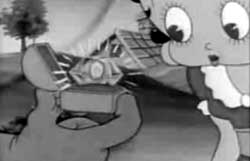 No! No! A Thousand Times No! (1937) opens on theatrical stage with a full house. This is a variation of the theme filmed twice in 1934 as She Wronged Him Right and Betty Boop's Prize Show, which were likewise Victorian-style melodramas performed on stage with Handsome Fred.
No! No! A Thousand Times No! (1937) opens on theatrical stage with a full house. This is a variation of the theme filmed twice in 1934 as She Wronged Him Right and Betty Boop's Prize Show, which were likewise Victorian-style melodramas performed on stage with Handsome Fred.
Betty & Fred are starring in this melodrama as lovers. While they kiss & make time on a park bench, a hot air balloon passes by with the villain on the look-out for his the target of his cruel affection.
The balloon is lowered to the stage by a winch & the villain climbs out to tie Fred to a tree, then tries to make time with Betty. "What do you say, toots?" asks he. "But I do not love you sir!" quoth Betty.
Resisting his bribes of diamonds, pearls, & furs, she sings the title song: "No! No! A thousand times no!/ You cannot buy my caress/ No! No! A thousand times no/ I'd rather die than say yes."
"So! You spurn me!" exclaims the cad as he snatches her up in his arms while she beats at him helplessly with her tiny fists. Trapping Freddy in a ring of fire lit around the tree Fred was already tied to, the cad then whisks Betty away in his balloon.
"I'll save you Betty! Here I come!" shouts Fred as he stamps out the fire & turns the tree into a catapult shooting himself up to the balloon for a fist-fight. The play (& the cartoon) ends with Betty saved, the villain punished, & Fred & Betty smooching.
This wasn't much of a story or cartoon either, & the song certainly wasn't any good, but we were shown a bit of the "behind the scenes" as to how the balloon flight & raging storm was created on stage, & that was quite fun.
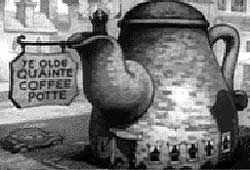 Inside Ye Olde Quainte Coffee Potte (a coffee pot shaped cafe just like one that still exists in Tacoma, Washington) Betty Boop works as a cook. In On With the New (1938) she wears a long skirt toning down her sexiness.
Inside Ye Olde Quainte Coffee Potte (a coffee pot shaped cafe just like one that still exists in Tacoma, Washington) Betty Boop works as a cook. In On With the New (1938) she wears a long skirt toning down her sexiness.
The waiter calling out orders spoofs a greasy spoon lingo that pretty much no longer survives in the independent restaurant industry but is fun to hear:
"Ham on rye! Seven sinkers! Corn beaf & garbage! Fried toast slap 'em in the eye!" Betty replies between each order, sometimes a little Popeye-esque in the way she mumbles. "You got pigs feet?" calls the water. "Don't get personal," replies Betty.
She's working herself ragged & complaining wittily the whole time. While doing dishes she says, "If I ever get out of here I'll never wash again." Unexpectedly a telegram arrives at the kitchen door for Miss Boop, accepting her in a position she applied for as Nursery Attendant.
She's delighted to escape her horrible job as a cook, & sings, "Off with the Old Job, On with the New," a bouncy little jazz number.
Her new job is taking care of babies, in a place set up like a factory assembly line. Doesn't look any better than her previous job to me, & it's always sad to see Betty reduced from stardom on the vaudeville & burlesque stages to chief cook & bottle washer or babysitter, thanks to the Production Code of 1934.
The babies turn out to be pretty hard to handle, & cause mass mischief when they're supposed to be in their beds. Eventually Betty flees the nursery in horror, returning to her cook's position happy to have it.
This one's fairly entertaining for a later Boop episode. When the babies douse her with a hose we get to see her with her hair wrecked. The design of the babies is too limited; they all look the same, & the naughtiness gags aren't particularly imaginative.
Betty's kitchen gags were few but good ones. She's taller & less plump than in most of the later Boops, so that her dress can be longer & still show legs from the knees down, an attempt to make concessions to the Production Code without totally losing Betty's nature.
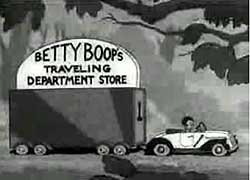 In Be Up to Date (1938), Betty visits Hillbillyville "Down the Road a Piece," with Hoagy Carmichael's "Lazybones" as an instrujmental on the soundtrack, & an unusully well designed set with three-demensional backdrop.
In Be Up to Date (1938), Betty visits Hillbillyville "Down the Road a Piece," with Hoagy Carmichael's "Lazybones" as an instrujmental on the soundtrack, & an unusully well designed set with three-demensional backdrop.
It's a whole town of run-down cabins & moonshine swillin' lazy hillbillies lounging everywhere.
Betty Boop arrives in her smart little sports car pulling a huge wagon that says "Betty Boop's Travelling Department Store," singing as she goes about all the stuff her store offers for sale, ending with the lyrics, "I'm coming round the mountain, round & round the mountain, to bring you hillbillies up to date."
"Boy oh boy do I expect to do business," says she, unfolding her tented department store & performing more of her song, "Be up to date! Be up to date! You & you & you, before it's too late."
The hillbillies find novel uses for modern items. A toaster is used to fire objects for target practice. A motor for a motor boat operates a plow. A waffle iron shapes a hillbilly lady's hair.
Several modern items become hillbilly musical instruments. Betty can hillbilly-dance with the best of 'em. At the end all of Hillbillyville is singing her "Be up to Date" song as she folds up her store & continues on.
Amusing, perhaps not to so much so for hill folk. Oddly enough, the same script was later used for a Popeye episode.
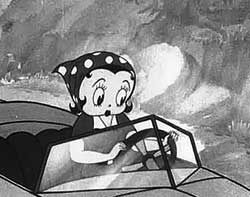 Musical Mountaineers (1939) could almost stand as a second chapter to Be Up To Date.
Musical Mountaineers (1939) could almost stand as a second chapter to Be Up To Date.
Betty's car breaks down in "feud country" where the Hatfields & the McCoys live, though the McCoys are renamed the Peters for unknown reasons.
The backfiring car convinces the Peterses that the Hatfields are coming fully armed, & they arm themselves accordingly.
Betty introduces herself as a professional dancer so they fire their rifles at her feet to make her dance, which she does right well. So they whip out their musical instruments & begin a jazzy hillbilly tune. Betty plays kazoo.
Two hilljanes sing "There Ain't No Gold Them Thar Hills." Betty close-dances with one of the girls, one of her few lesbian moments in her entire cartoon career, though I always suspected.
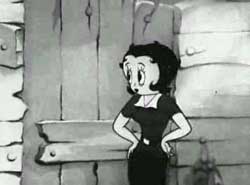 The hillbilly tune "Who Cares" was performed by a real band known as "The Hatfields" after the famous feuding family. The hillbilly tune "Who Cares" was performed by a real band known as "The Hatfields" after the famous feuding family.
This cartoon got me remembering an old pal of mine from years ago. There are to this day periodic get-togethers in Kentucky or other designated locations for Hatfield & McCoy descendants to get together. These are very well attended peaceful events though it remains traditional to do a little mischief against each other. An old friend of mine, Marshal Hatfield, picked up a hitchhiking McCoy while on the way to one of these gatherings, & he stole some stuff out of her truck for a joke, returning it later at the gathering.
I wonder if the band The Hatfields really were members of that clan, since there have always been plenty of them around; & are the modern Appalachian bluegrass group The Hatfields (who definitely are descended from the feuding family) related to the 1930s group? I dunno.
Betty has a rather long dress & it's not even tight fitting, as complaints about her sexiness strongly influenced what Paramount would let the Fleischers do. Even the lack of jazz, in the thirties still demeaned as "colored" music, is very likely removed due to pressure. It'd be nice to think the Fleischers made it for hillbillies as a sly criticism of their own.
The Peters fill Betty's tank with moonshine & she continues on her way. The cartoon was bui8lt around a most minor Betty tune, but lively & fun even so.
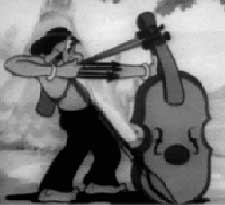 The Fleischers must have known this was going to be the last Betty Boop cartoon, since they were scheduled long in advance, yet they made no effort to have her go out with a bang.
The Fleischers must have known this was going to be the last Betty Boop cartoon, since they were scheduled long in advance, yet they made no effort to have her go out with a bang.
Rhythm on the Reservation (1936) is embarrassing with its stereotyping. They do at least make Betty a swing band singer instead of a maid or farmer or a babysitter.
She's driving along with her car full of the band's instruments when she spots an "Ug!" style Indian man & woman with a roadside stand called Wigwam Beauty Shoppe, for which there is a sign reading "Try Our Scalp Treatment."
Betty wants to add the tomtom to her collection of band instruments, but Mrs. Redskin doesn't want to part with it.
Meanwhile the thieving tribe has swiped all her musical instruments. They're so stupid they think the accordian is a fire bellows, the violin is a firemaking device like rubbing two sticks together, the violin case is a child's canoo & the banjo a paddle, the kettle drum a cooking pot, the trumbone is a water pump, the sax a peacepipe, the harp is a blanket loom, & so on.
Betty has to show them how to use the kettle drum. Slowly everyone learns what their instruments are for & Betty sings a swing tune to an Indian beat while the Indians dance around her.
Imagine being, say, a Navaho who actually did in those days sell stuff at the side of the road to passing whiteskins, heading off to the moviehouse one night, & seeing a cartoon that alleges Indians are so ignorant they can't even beat a drum right if a white chick didn't teach 'em. It was a sad farewell for Betty, sigh.
copyright © by Paghat the Ratgirl
|
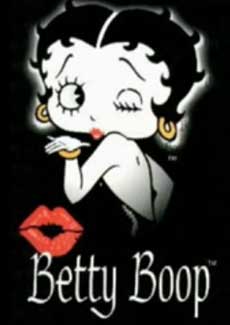




 The hillbilly tune "Who Cares" was performed by a real band known as "The Hatfields" after the famous feuding family.
The hillbilly tune "Who Cares" was performed by a real band known as "The Hatfields" after the famous feuding family.